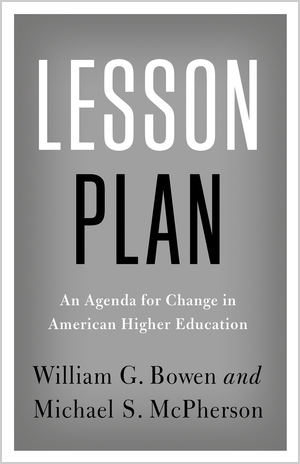 Last week marked the passing of Dr. William G. Bowen, former provost and president at Princeton University, president of the Mellon Foundation, and author of several noteworthy books on higher education. During his tenure at the Mellon Foundation, he created an internal research division, the non-profit reference sources JSTOR and ARTstor, and the iThaka research foundation dedicated to examining the interface between technology and education. The books he authored or co-authored include: The Shape of the River with Derek Bok (2000), The Game of Life (2002), Reclaiming the Game (2005), Crossing the Finish Line (2009), Higher Education in the Digital Age (2013), and Lesson Plan (2016).
Last week marked the passing of Dr. William G. Bowen, former provost and president at Princeton University, president of the Mellon Foundation, and author of several noteworthy books on higher education. During his tenure at the Mellon Foundation, he created an internal research division, the non-profit reference sources JSTOR and ARTstor, and the iThaka research foundation dedicated to examining the interface between technology and education. The books he authored or co-authored include: The Shape of the River with Derek Bok (2000), The Game of Life (2002), Reclaiming the Game (2005), Crossing the Finish Line (2009), Higher Education in the Digital Age (2013), and Lesson Plan (2016).
Bowen, along with his fellow Princeton economist William Baumol, also coined the term “cost disease” to describe the higher than inflation spending in higher education in the 1960s and beyond. I had the good fortune to meet him at a conference a few years ago where we discussed the potential for online learning to influence the higher education cost curve. His influence on higher education was monumental.
The National Bureau of Economic Research (NBER) released a paper co-authored by David Demin, Michael Lovenheim, and Richard Patterson that examines tuition pricing and enrollment across sectors since the 50/50 rule was eliminated by Congress in the 2006 Higher Education Act reauthorization (note: the 50/50 rule required institutions to enroll no more than one online student for every face-to-face or onground student). The paper is inconclusive about the impact of online education on public institutions, but the researchers cite evidence that private institutions in near-monopoly markets saw decreased enrollments and tuition pricing after the climb in online enrollments.
In an Inside Higher Education article, Russ Poulin, director of policy and analysis for the WICHE Cooperative for Educational Technologies (WCET), agreed with the paper’s findings about declines in enrollments in monopoly markets but disputed the authors’ assumptions that colleges are attracted to online education because it enables them to cut costs. Instead, he argues that online education allows many colleges to expand their market share by serving adult learners who prefer the convenience of attending online programs. I agree with his comment about market expansion and note that another NBER report was issued recently that discussed the expansion of learners enabled by Georgia Tech’s online Master’s of Science degree in Computer Science. In addition, the Integrated Postsecondary Education Data System (IPEDS) has had a limited ability to differentiate between online and onground learners until very recently, so some of the IPEDS data may not capture all of the online learners.
A federal appeals court (the Eighth Circuit) upheld a lower court ruling allowing a community college in Minnesota (Central Lakes College) to dismiss a student from a nursing program because of comments the student made on Facebook. While the judges disagreed about whether the statements were protected under the First Amendment, they ultimately decided that the program the student was enrolled in was covered by a code of ethics. Attorneys for the Foundation for Individual Rights in Education (FIRE) were disappointed in the decision which they believe gives institutions the ability to “do an end run around the First Amendment.” They warned that anyone who enrolls in a public university program with a professional code of conduct should understand that their behavior at all hours may be used against them. I suspect this is not the last court case we’ll see governing students’ freedom of speech using social media.











